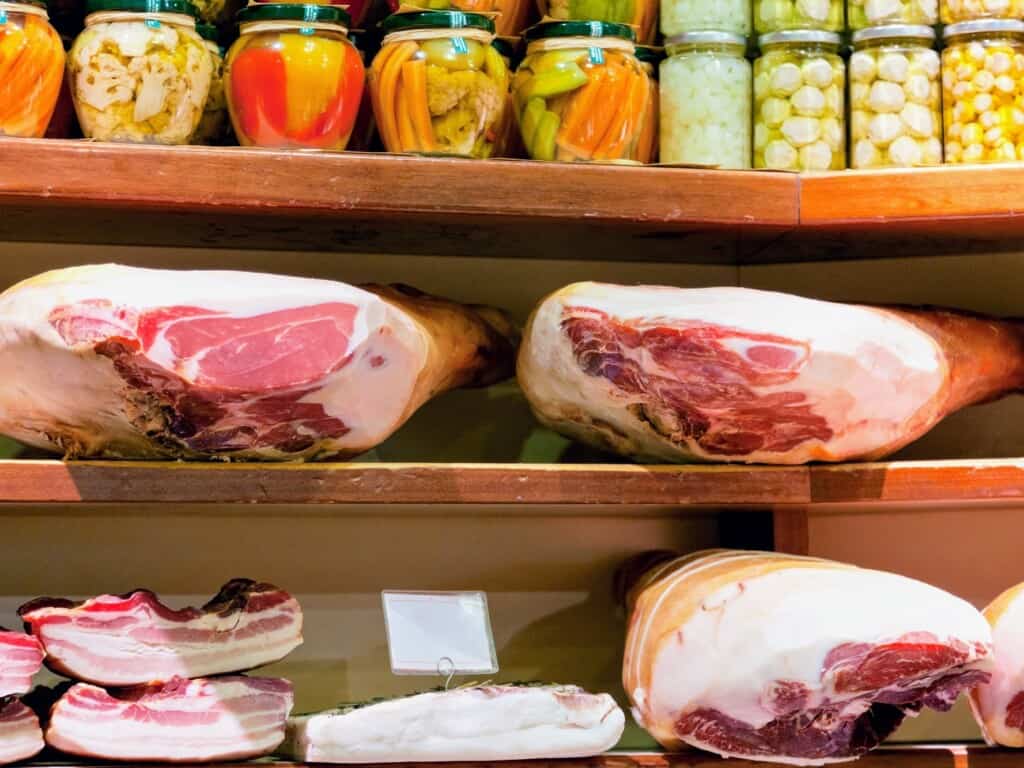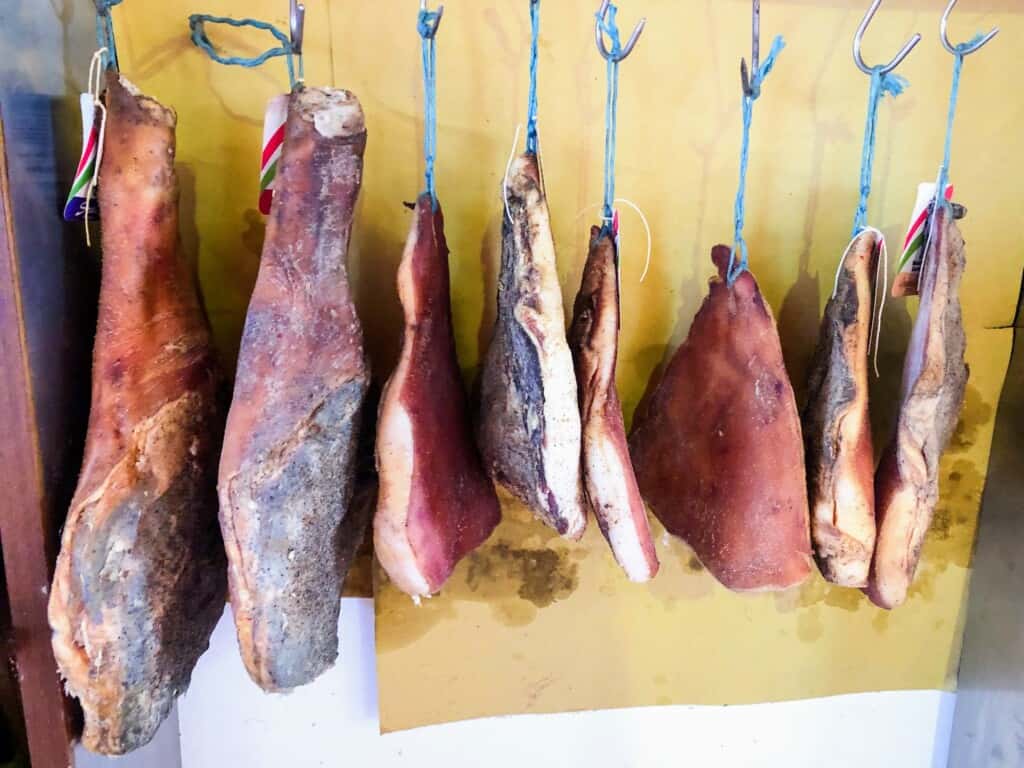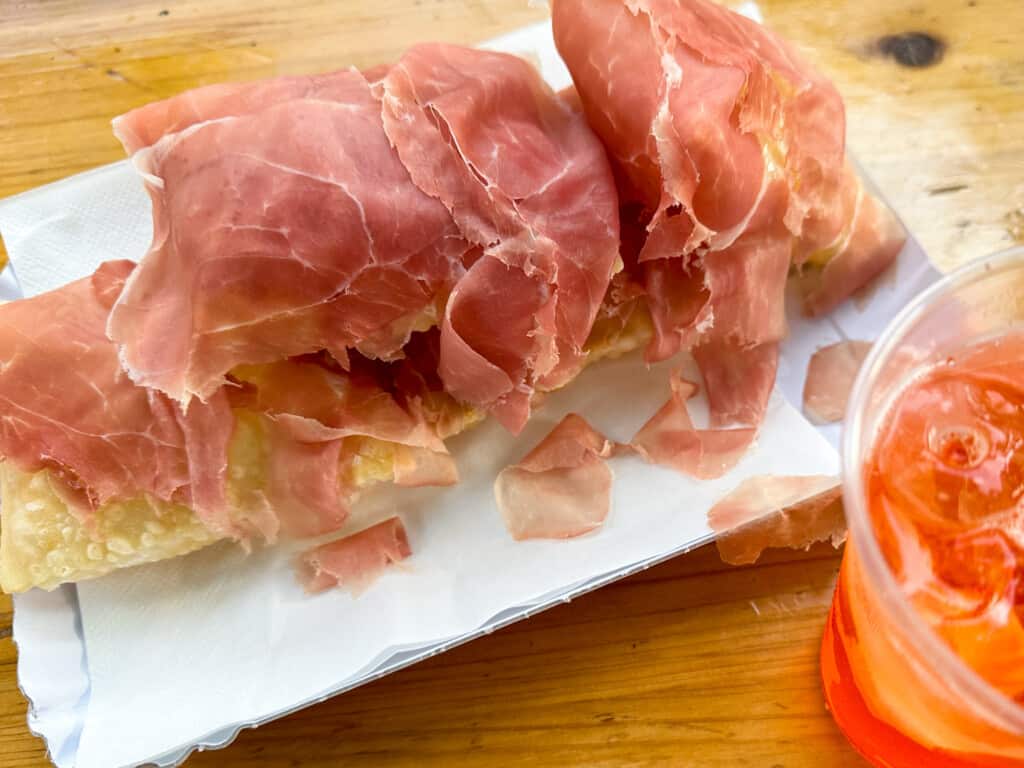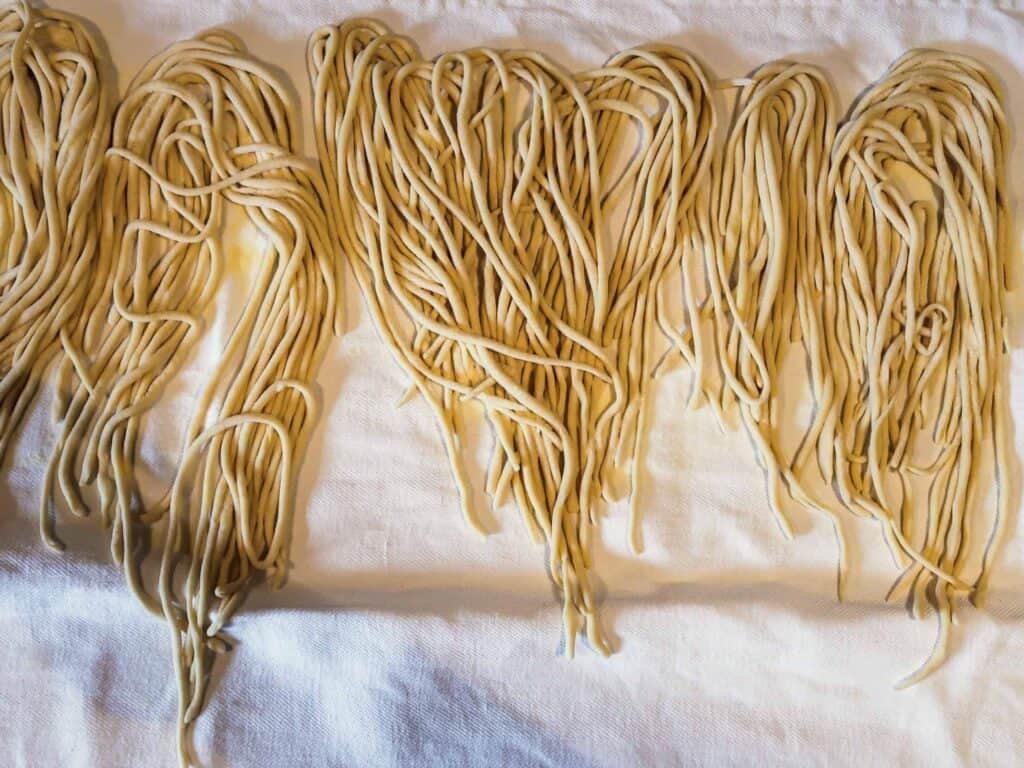Last updated on October 26th, 2023
Prosciutto crudo vs cotto – what’s the difference?
The answer is simpler than you think. In this article I’ll fill you in on:
- the main differences between prosciutto crudo and prosciutto cotto
- how to pronounce them
- the most popular kinds of prosciutto crudo and cotto
- how to eat them
Don’t hold up the deli line again with your doubts about prosciutto crudo vs cotto. Let’s dive in!
Jump to Section
How To Pronounce Prosciutto In Italian
First off, prosciutto is pronounced proh-shoot-toh.
Listen to the pronunciation of prosciutto here:
You may need to listen a couple of times. Prosciutto is one of the most commonly mispronounced food words in Italy.
What Is Prosciutto?

In Italian, the term prosciutto means ham of any kind. It can be cooked (cotto) or cured (crudo). Specific kinds of prosciutto may have different names based on their geographical region of origin and on any certification of quality production such as PDO and PGI.
Certified PDO and PGI Italian Prosciutto
Prosciutto that has been produced and packaged in accordance with strict guidelines of production from the initial raising of the pigs to the finished prosciutto, conducted in a specific geographical location within Italy can be awarded a special certification of quality.
- The certification PDO (Protected Designation of Origin) is awarded to prosciutto that are produced in a specific place and adhere to specific phases of production that follow strict regulations (DOP in Italian), including the breed of pig used, such as prosciutto di Parma DOP.
- The certification PGI (Protected Geographical Indication) is awarded to prosciutto that originate in a specific place. Only one of the production steps must take place in this same geographical area according to looser guidelines (IGP in Italian) such as prosciutto di Norcia IGP
For example, anyone in the world can make prosciutto but unless it’s produced within the specific geographical location of Emilia-Romagna according to the specific breed of pig, original recipe and traditional practice of aging, it cannot by law be called prosciutto di Parma.
Fact: PDO and PGI labels can be awarded to any food in Italy such as cheese and sausage.
Non-Italian Prosciutto
The terms prosciutto and prosciutto crudo are not protected, although specific varieties within these categories are. Prosciutto can really be made anywhere in the world and labeled prosciutto. The difference lies in the specific names of the prosciutto.
Regional types of prosciutto such as prosciutto toscano DOP cannot be made outside of Tuscany and be called this.
Prosciutto Crudo Vs Cotto At A Glance
| Prosciutto Crudo | Prosciutto Cotto |
| meaning ‘raw’ | meaning ‘cooked’ |
| dry-cured with salt | cooked |
| bold, aromatic and complex in flavor | light, delicate, flavor |
| takes over a year to make | made in a matter of days |
| from the hind legs of the pig | from the hind legs of the pig |
| dark red | light pink |
| marbled with fat | relatively lean |
| bone-in | boneless |
How To Pronounce Prosciutto Crudo
Prosciutto crudo is pronounced proh-shoot-toh kroo-doh in Italian
Listen to the pronunciation of prosciutto crudo:
What Does Prosciutto Crudo Mean?
Prosciutto crudo means raw ham in Italian, crudo translating to “raw”.
Learn More: Read about the 9 Types of Prosciutto to Look for on Your Trip to Italy.
What Is Prosciutto Crudo?

Prosciutto crudo is a dry cured bone-in ham made from high-quality pork taken from the hind legs of the pig, meant to last for an extended period of time. The process of making prosciutto crudo can take years, unlike prosciutto cotto, which is a relatively quick process. Prosciutto Crudo is characterized by a deep red color, marbled with streaks of rich, white fat.
Fact: Different prosciutti crudi are aged at different temperatures and humidity levels.
Prosciutto crudo can further be subdivided between prosciutto dolce e prosciutto salato, sweet and salty.
Fact: Prosciutto crudo is never cooked.
Prosciutto Crudo Dolce
Prosciutto crudo dolce (meaning sweet) refers to prosciutto crudo that is not quite as salty as other versions. It’s considered more refined, more mild and best served sliced as thinly as possible.
Prosciutto Crudo Salato
Although all prosciutto crudo is salty (salato meaning salty), many rustic versions such as prosciutto toscano are seasoned heavily with salt and sometimes other herbs and spices, making them even more savory. These varieties tend to be sliced thicker and sometimes by hand.
Prosciutto crudo that is very salty pairs well with food items that are bland such as pane toscano or ingredients that provide high contrast such as melon or figs.
What Does Prosciutto Crudo Taste Like?
Prosciutto crudo varies significantly in the type you get, which depends on how much salt and what kind of spices were used in the curing process. Some are spicery and more aromatic while other sweeter versions are less salty and considered more mild.
Prosciutto crudo is anyhow a very salty cured meat with a melt-in-your mouth sensation.
How Prosciutto Crudo Is Made

The process of making prosciutto crudo is much more complex than that of prosciutto cotto.
Both prosciutto crudo and cotto start the same way by thoroughly removing the pig’s hind leg and cleaning it.
Fact: Prosciutto crudo might be tagged with a kind of round, metal button indicating the date it began curing.
The prosciutto leg is then salted by a master known as the Maestro Salatore in Italian and left to dry out. The process of salting the prosciutto leg is very important for pulling out all the moisture and blood, making it safe to eat.
Next, prosciutto crudo is washed and seasoned again by hand, according to a specific recipe that may or may not include other spices. The exact recipe for the amount of salt being added to the prosciutto depends on what kind of prosciutto is being made. Some regional varieties are cured with salt and other seasonings but not all. It is then left to dry in a tightly controlled environment in terms of temperature and humidity.
Fact: Prosciutto crudo is still considered an artisan craftsmanship in Italy which is why you will notice such large differences between different kinds and varieties for sale.
The aging process depends on the type of prosciutto crudo but it generally lasts anywhere from 12-36 months. The longer the aging process, the more complex the flavor of the final prosciutto crudo will be.
For DOP viarites, prosciutto crudo goes through various inspections to ensure quality. The inspector pierces the ham in multiple locations with a horse bone needle before sniffing to check for rancid odors.
At this point, the prosciutto is ready to be packaged, distributed and sold. Prosciutto crudo can be purchased either sliced, in large pieces or even as a whole leg.
Popular Types Of Prosciutto Crudo

There are several types of prosciutto crudo in Italy, all of which follow different recipes for salting, and curing. These are just a few.
- Prosciutto di Parma: made from a particular heritage pig breed, this prosciutto dolce is considered the king of all Italian hams (Emilia-Romagna)
- Prosciutto di San Daniele: a sweet variety characterized by its unique guitar-shape created by pressing the meat after it has been salted (Friuli-Venezia Giulia)
- Prosciutto Toscano: with a more pungent and distinct flavor achieved with the use of pepper, rosemary and juniper in the salting process, prosciutto toscano is very salty (Tuscany)
- Prosciutto di Modena: made around the basin of the Panaro river, this version is mild and sweet. (Emilia-Romagna).
- Prosciutto di Carpegna: made from the Pesante Padano pig breed, this prosciutto crudo is coated in a lard-and-spice blend, creating a unique texture and flavor (Le Marche)
How To Serve Prosciutto Crudo

Prosciutto crudo is really at its best when sliced as thinly as possible. There are, however, many Italians, especially in central Italy who take a more rustic approach to slicing prosciutto. In Tuscany and Umbria, for example, prosciutto is enjoyed cut by hand in thicker slices.
The reason for serving prosciutto crudo sliced paper-thin is because the cured prosciutto crudo easily melts in your mouth, allowing you to fully take in all aspects of its sweet, salty flavor. The more marbled the prosciutto, the better it will melt in your mouth and well-balanced it will be.
How To Use Prosciutto Crudo

Because prosciutto crudo is such a high-quality product, it’s best served raw, next to other distinct flavors that will compliment it.
Serve prosciutto crudo on a charcuterie board or alongside other cheeses on a mixed board, known as a tagliere misto in Italian.
Prosciutto crudo is one of Italy’s most beloved items to put between two slices of bread, schiacciata, or focaccia to make a panino.
Italian Recipes With Prosciutto Crudo

- prosciutto e melone – with melon
- prosciutto e fichi – with figs
- saltimbocca (Lazio) – beef slices cooked with prosciutto
- involtini di vitello (Tuscany) – veal slices cooked with sage and prosciutto
- crostini
- pizza – added after cooking
What To Pair With Prosciutto Crudo

Prosciutto Crudo is much more complex and sophisticated than prosciutto cotto. It has a very intense, aromatic flavor that pairs well with more mild and sweet ingredients such as mozzarella, burrata, melon, figs, pears and simple breads.
Light white wines are best paired with prosciutto crudo.
How To Pronounce Prosciutto Cotto
Prosciutto crudo is pronounced proh-shoot-toh coht-toh in Italian.
Listen to the pronunciation of prosciutto cotto:
What Does Prosciutto Cotto Mean?
Prosciutto cotto literally translates to ‘cooked ham’ in English.
What Is Prosciutto Cotto?

Prosciutto cotto is a boneless cooked ham made from high-quality pork from the hind legs of the pig. Unlike prosciutto crudo, the process of making prosciutto cotto takes only a matter of days but can then be enjoyed for a long period of time, if stored properly.
Prosciutto cotto is first brined and then steamed. It’s pale pink with a light, delicate flavor and produced across the Italian peninsula.
In the process of cooking, most of the fat dissolves, creating a lean, rich ham that is much lower in sodium when compared to its counterpart, prosciutto crudo.
Fact: In Italy, prosciutto cotto can be abbreviated to just cotto. if you ask for cotto, you are asking for prosciutto cotto.
How Prosciutto Cotto Is Made
First the hind leg is removed from the pig, washed and deboned. The leg of ham is massaged with salt, pepper, bay leaves, and other flavorings such as juniper, and then slowly cooked in a salty brine, sometimes flavored with other herbs and spices at a low temperature for several days and up to four.
This prosciutto is slowly cooked at controlled temperatures, then cut into tender, moist slices. Sometimes prosciutto cotto is seasoned or brined with herbs, spices, and even truffles for added flavor.
Types Of Prosciutto Cotto

What defines a type of prosciutto cotto is the percentage of humidity in the cooked ham. Generally speaking, the lower the humidity, the higher the quality of the prosciutto cotto is. The most ‘common’ and widespread level of humidity is around 79.5% and 82%.
“Choice” prosciutto, called scelto in Italian, has a humidity level between 76.5% and 79.5%.
The highest quality of prosciutto, known as alta qualità, should not have a humidity level greater than 76.5%.
Fact: The level of humidity within a cooked ham is dependent on how concentrated the brine is, how long it’s brined for and for how long it’s cooked.
How To Serve Prosciutto Cotto
Cotto is still best thinly sliced but not as thinly as prosciutto crudo. When you are ordering prosciutto from a deli, ask for it tagliato fine or cut thinly to be sure you are getting what you want. If you want it thick, ask for it tagliato un po’ più alto (cut a bit thicker).
Because prosciutto cotto is much less complex than its counterpart, prosciutto crudo, it works well with many flavors. The most widespread use of prosciutto cotto is in a panino or alongside strong cheeses such as pecorino. Strong cheeses are a good pairing for prosciutto cotto because they balance out the delicate flavor of the ham.
How To Use Prosciutto Cotto

Prosciutto cotto is most commonly purchased and consumed as a deli meat but it also holds up well to cooking.
Best Ways To Use Prosciutto Cotto
- on pizza (always add after pizza is cooked)
- in panini (sandwiches)
- on charcuterie boards
What To Pair With Prosciutto Cotto
Prosciutto cotto pairs well with both soft and hard cheeses. The creamy cheese melds beautifully with the mild flavor of the cotto yet at the same time, strong cheeses such as gorgonzola or scamorza won’t overwhelm it.
Enjoy prosciutto cotto with a fresh, crisp white wine.
Can You Substitute Prosciutto Crudo For Prosciutto Cotto?

The flavor profiles and textures of both prosciutto crudo and cotto are so completely different that it’s very hard to substitute one for the other.
If you are topping a pizza or making a sandwich, you can absolutely substitute one for another but if you are following a specific recipe such as prosciutto e melone, it’s not a good idea to substitute with prosciutto cotto because the cotto lacks the texture and salty, complex flavor of the crudo.
When substituting different kinds of prosciutto crudo, there are no restrictions. Substitute prosciutto di San Daniele for prosciutto di Parma without thinking twice.
Prosciutto Crudo Vs Cotto FAQ
American prosciutto is defined by where it’s made and how it’s made, without regulations (i.,e. in America with any pigs and aged in any way according to any given recipe). Italian prosciutto with specific names and certifications is made within strict geographical confinements and upheld to strict laws of production.
There is prosciutto cotto, which is brined and cooked and then prosciutto crudo, which is uncooked but cured, making it safe to consume.
Prosciutto di Parma is considered the king of all prosciutto for its incredible flavor, silky texture and melt-in-our-mouth consistency. It’s not overly salty but rather, perfectly balanced.
There are several different types of prosciutto crudo but the most famous is the prosciutto crudo di Parma and the prosciutto crudo di San Daniele, both of which are considered ‘sweet’ varieties.
Prosciutto literally means “ham” in English but within this category, there is both prosciutto crudo (raw meaning cured) or cotto (cooked). Prosciutto cotto is literally deli ham.




